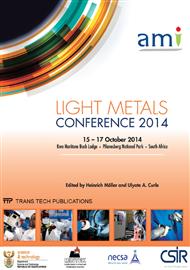p.90
p.96
p.103
p.112
p.120
p.126
p.133
p.143
p.152
Closed-Loop Temperature Control of Material Plasticisation during Friction Stir Welding
Abstract:
This research presents the potential for improved joint integrity of friction stir welding by controlling the plasticisation temperature in the weld nugget. During a typical FSW, temperature fluctuates with position along the length of the weld. Working from a basis that for all material and tool geometries, there is an Optimal Plasticisation Temperature (OPT), this paper provides a strategy for maintaining this optimal weld temperature by adjusting selected weld input parameters ensuring consistent joint quality, irrespective of component geometry or clamp configuration. This proposed methodology can also be used to determine the OPT for different FSW tool geometries and material combinations. Advanced monitoring and control strategies are essential to ensure that FSW can be made a more robust industrial process that can keep pace with the modern demand for more consistent production and reliability of welded structures. The potential lies in the possibility for an operator to now select an OPT point for a specific approved welding program and allow the welding platform to maintain the OPT via closed-loop temperature control which adjusts tool rotation and or tool traverse speed. This paper further reports on the potential of integration of a closed-loop temperature control algorithm for FSW. The system measures the temperature inside the FSW tool using thermocouple sensors (creating the feedback signal). The controller then applies a PID algorithm which in turn drives the spindle speed (and if necessary, tool traverse speed) in order to change the energy input rate to the weld for controlling plasticisation temperature.
Info:
Periodical:
Pages:
120-125
Citation:
Online since:
October 2014
Authors:
Keywords:
Price:
Сopyright:
© 2014 Trans Tech Publications Ltd. All Rights Reserved
Share:
Citation:


